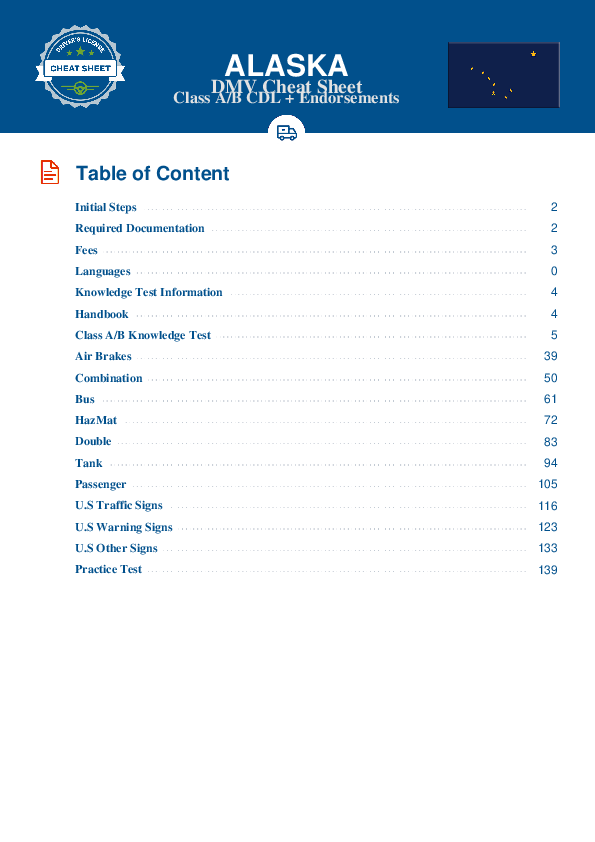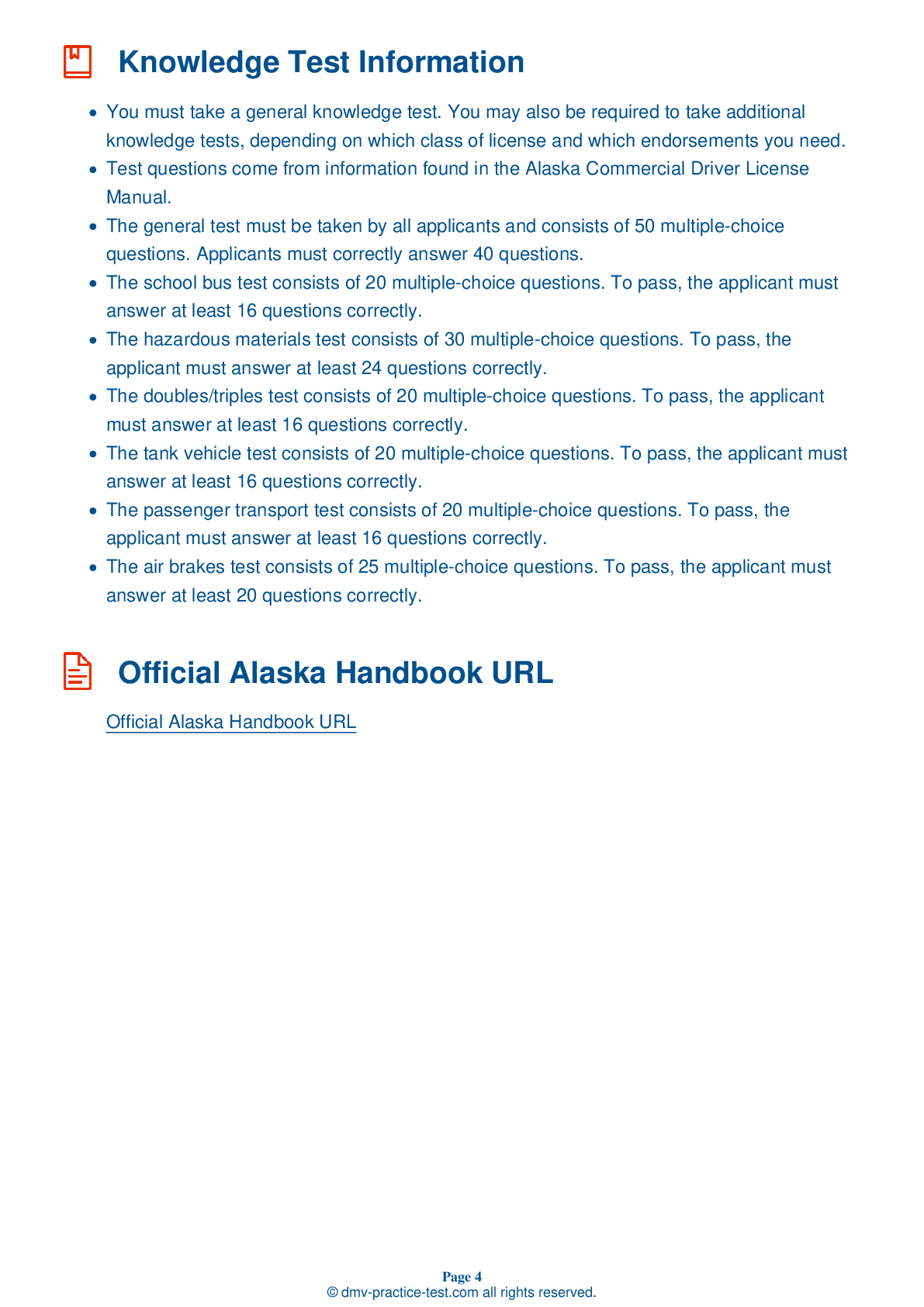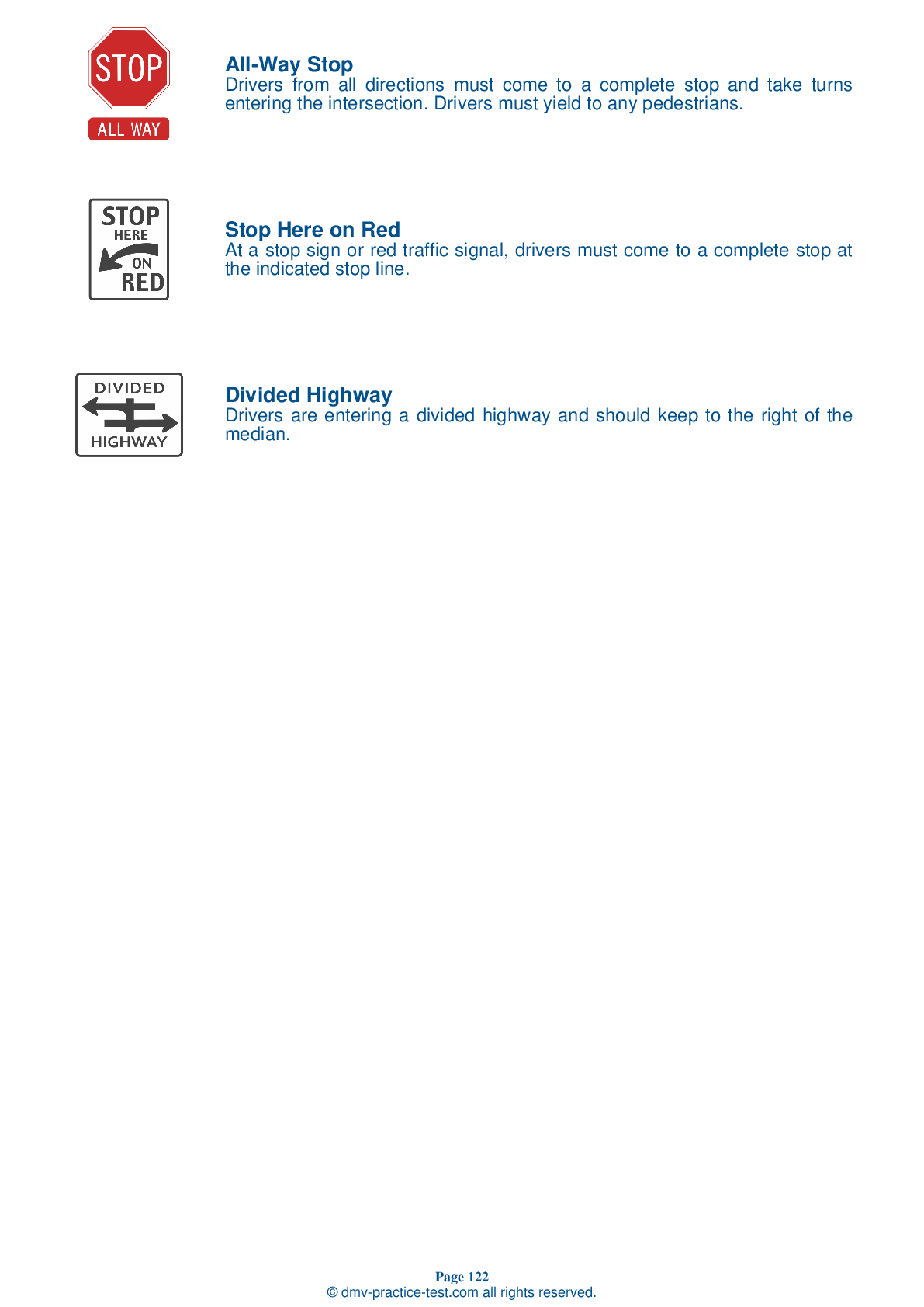Knowledge Test Class A #1
Class A Driving Test | Alaska 2025 #1 Page 6 of 7
Train for FREE online with our Alaska class A license test. The official exam test consists of several obligatory parts, with all of them checking your knowledge of different blocks of road rules. If you need to obtain a AK CDL class A permit in 2025, practice as much as possible. Free sample tests published on our website will help you check and improve your knowledge and boost your grades. Please bear in mind that CDL class A requirements may vary from state to state.
50
40
20
36 . If planning to stop on the road to unload cargo, you should:
You should tap your brakes and flash your brake lights to warn other drivers any time you plan to slow or stop where other drivers may not expect you to do so. Use this technique when stopping on the road to unload cargo or passengers.
37 . If the brakes pull to one side or the other when used:
If the brakes pull to one side or the other when used, it is an indication of brake trouble.
38 . When parking, you should not use the parking brake if:
If your brakes are hot after coming down a steep grade, you should not use your parking brake when parking. Let your brakes cool before applying the parking brake or risk damaging the brakes.
39 . Hydroplaning:
Hydroplaning is an effect in which a vehicle's tires lose traction with the surface of the road and instead glide along a layer of water. There does not have to be a large amount of water on the road for this to occur. Hydroplaning can begin at speeds as low as 30 mph.
40 . Placards should be used:
Warning placards are required to be used any time a vehicle is carrying designated types and amounts of hazardous materials. A placarded vehicle must display placards on all four of its sides.
41 . For safety purposes, when should you turn off a retarder?
Retarders are mechanisms in some vehicles that help slow a vehicle and reduce the need for braking. However, using a retarder may cause wheels to skid when they have poor traction. Turn off retarders when traveling under wet, snowy, or icy conditions.
42 . When backing a truck, you should:
Backing a commercial motor vehicle is always dangerous because you cannot see everything behind you. When backing, make frequent checks of the mirrors on both sides of the vehicle. Use a helper whenever possible.
2025 Alaska | Frequently Asked Questions
A CDL Class B license in Alaska allows the holder to operate any single vehicle with a Gross Vehicle Weight Rating (GVWR) of 26,001 pounds or more, or any such vehicle towing a vehicle not exceeding 10,000 pounds GVWR. This typically includes commercial buses, dump trucks, delivery trucks, and garbage trucks.
A Class B CDL license in Alaska allows the holder to operate vehicles such as city buses, tour buses, segmented buses, delivery trucks, dump trucks with small trailers, and garbage trucks. It's valid for any single vehicle with a Gross Vehicle Weight Rating (GVWR) of 26,001 pounds or more, or such vehicle towing a vehicle not exceeding 10,000 pounds GVWR.
To acquire a Class B CDL license in Alaska, you must be at least 18 years old (21 for interstate driving), possess a valid Alaska driver's license, pass a vision test, and successfully complete a general knowledge test. You must also pass a skills test in the type of vehicle you plan to drive, which includes a pre-trip vehicle inspection, a basic vehicle control test, and an on-road driving exam.
In Alaska, you must be at least 18 years old to qualify for a Class B CDL license for intrastate driving (within state borders). However, you must be at least 21 years old to engage in interstate driving (across state lines) or to transport hazardous materials.
While not always necessary, specific endorsements may be required for a Class B CDL license depending on the type of vehicle you plan to drive or the cargo you plan to transport. These could include endorsements for passenger vehicles, school buses, tank vehicles, or hazardous materials. Each endorsement requires passing a separate knowledge test and sometimes a skills test.
The Class B CDL skills test in Alaska encompasses three main areas: pre-trip vehicle inspection, basic vehicle control, and on-road driving. The pre-trip inspection examines your ability to assess your vehicle's safety. Basic vehicle control tests your ability to handle, turn, and stop the vehicle. On-road driving assesses your ability to drive safely in traffic.
Yes, Class B CDL license holders in Alaska are limited to operating vehicles weighing more than 26,001 pounds or towing vehicles weighing less than 10,000 pounds. They can also operate buses with a seating capacity of 24 passengers or more. However, they cannot drive Class A vehicles unless they have the appropriate endorsements and additional training.
In Alaska, the written Class B CDL test is primarily administered in English, in accordance with federal regulations. This is to ensure that all commercial drivers can read and understand traffic signs, signals, and other driving materials in English. Therefore, it's not typically offered in other languages.
Yes, you can request accommodations for the Class B CDL written exam if you have a disability. The Alaska DMV is committed to providing reasonable accommodations under the Americans with Disabilities Act. You'll need to provide documentation of your disability and specify your needed accommodations. It's recommended to make this request well in advance of your test date.
If you don't pass the Class B CDL written test in Alaska, you can retake it. However, you must wait at least one day before retesting. Keep in mind, there may be additional fees for each retest. It’s also recommended to study thoroughly and possibly seek additional training before attempting the test again.



